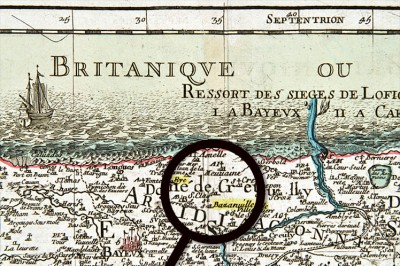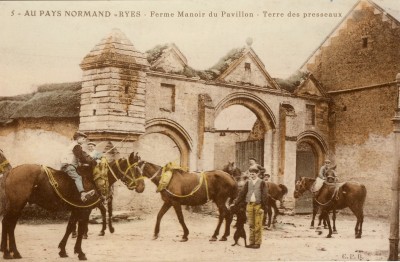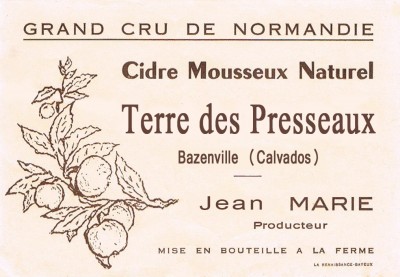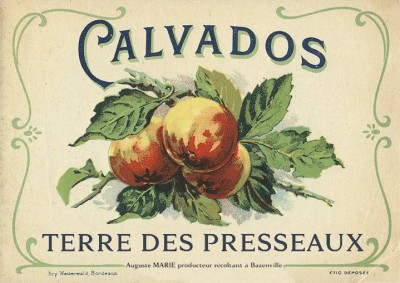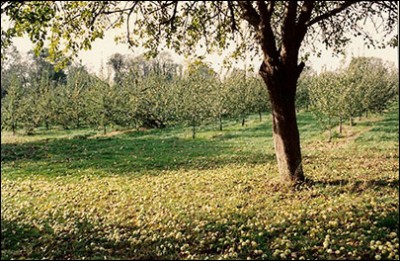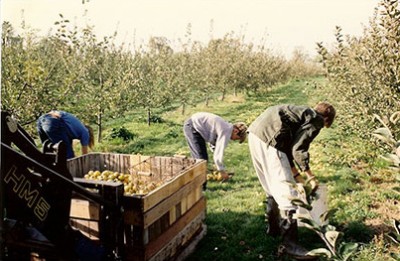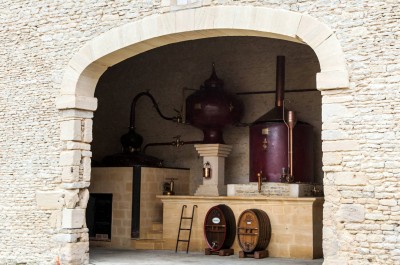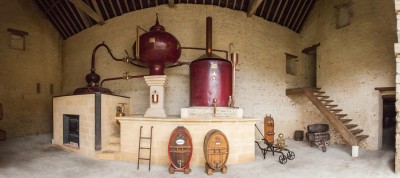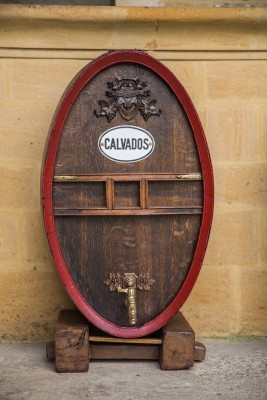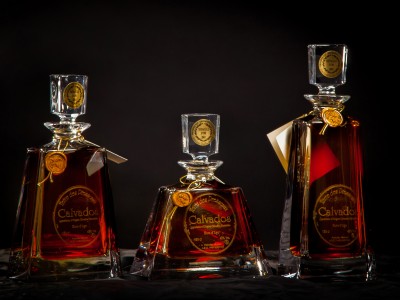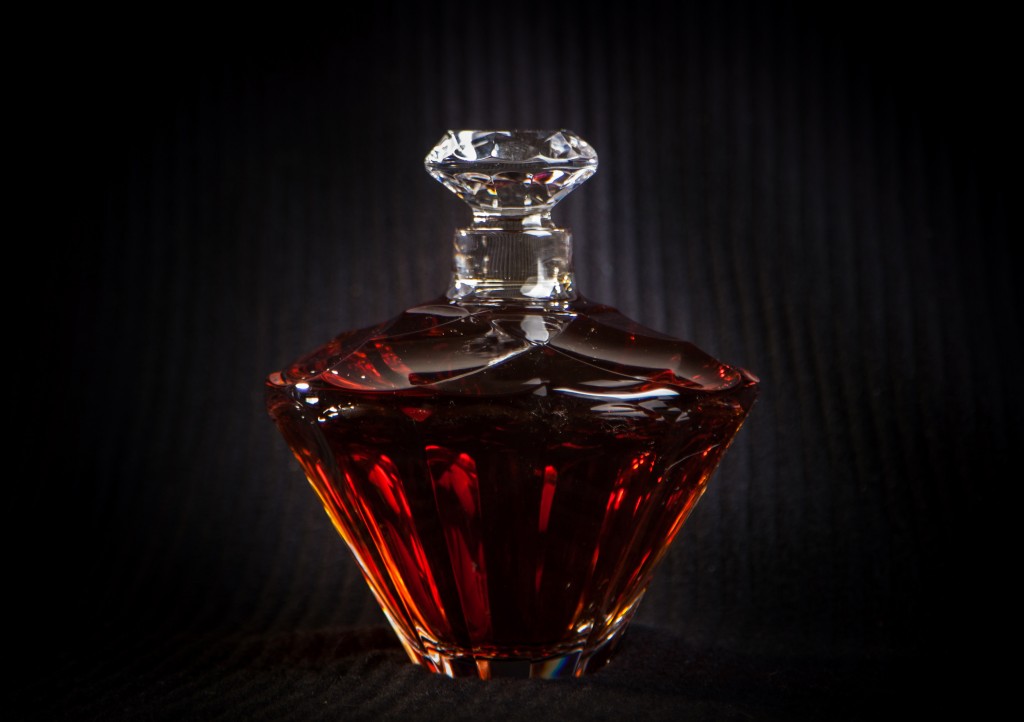Calvados is not manufactured, it grows in Normandy and nowhere else.
“A chain is only strong by its weakest link”. At all stages of our commitment to quality, our purpose is excellence.
The farm Manoir du Pavillon in the heart of the history of Calvados
« Calvados » and the canton of Ryes
The galleon San Salvador was part of King Philip II’s Armada. Defeated at the Battle of Gravelines, some of the Armada’s galleons tried to escape both northward and southward. That explains how in July 1588, the San Salvador put up with an explosion and ran aground on the coast of Canton de Ryes. The name 'Calvados' probably takes its origin either from this rocky coast named 'calva dorsa' (i.e. peeled crest in Latin) situated at what is called the Pit of Spain, or from the name of this galleon. In both cases, it all took place in the Canton of Ryes and since the XVIIIth century, the Norman cider brandy is called "Calvados".
William, Duke of Normandy, and the village of Ryes
In 1026, the Canton of Ryes was part of the Bessin County, former Frank diocese of Bayeux that became Norman under Rollon in 928. Raoul d'Argences, a Benedictine monk from Fécamp entrusted the land of Ryes to Thomas, Ranulf's son. It represented half of the parish and included La Ferme Manoir du Pavillon, plus half of the church shared with the Abbey of Longues-sur-Mer. During the winter of 1046, Hubert de Ryes and his sons - among whom Robert future bishop of Sées 1070-1082 - rescued William the Bastard (to become William the Conqueror) from a conspiracy of rebelled barons who were pursuing him since Valognes, north Cotentin. Hubert shoed William's horses back to front to mislead them. This trick, changed Normandy’s history, but also Hubert de Ryes and his family’s destiny. Despite their social Rank, his family accomplished an outstanding career.
From 1226 to 1732 we found track of Ryes leases and representation rights. In 1443, half of Ryes, including La Ferme Manoir du Pavillon, is mentionned as 'Barony of Ryes'. In 1668, the Abbey of Fécamp bestowed Ryes a freehold.
The farmhouse Manoir du Pavillon « Terre des Presseaux » in Ryes
"La Ferme Manoir du Pavillon" was built between the XIVth and the XVIIIth century on demand of the monks of the Abbey of Fécamp. The gate and the dwelling building (main one 'corps de logis') are from the XIVth century.The stairway tower and southwest end are from the XVth. The renovation of the gate and main buildings occurred during the first half of the XVIIth century. Farm buildings, barns, stables, cowshed, henhouse, carriage shed, bakehouse and, above all, the apple mill, the cider press, the still and vaulted cellar extend over 1000 sq.meters. The square dwelling tower had a roof in the shape of a pavillon (or a tent) which gave its name to the farm. On September 9th, 1599, according to a map of the XVIIth century, a royal edict authorised the construction of the bakehouse and the cider press. So in 1600, the monks bought quarry stones and ashlars at the nearby quarry of Creully.
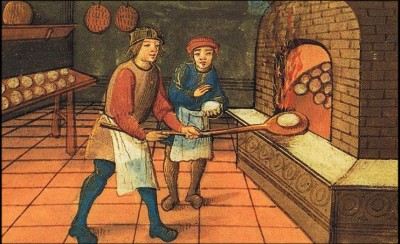
The production of cider and Calvados is quite an early tradition on this estate. If we refer to William de Gouberville's writings, we find there the first principles of distillation of the "cider brandy", which will soon get the brand name of "Calvados". In 1856, at the agricultural competition in Bayeux, La Ferme Manoir du Pavillon was awarded a prize for the quality of its plantation. The Canton of Ryes, including the town of Arromanches were, in 1944, in the heart of the allies landings in Normandy.
An ideal setting
The Terre des Presseaux soil
Since 1870, on this same county, in Bazenville, 2,8km away from Ryes, the land named "Terre des Presseaux" has been producing a famous vintage with apples exclusively harvested on the property managed by the Marie family - Auguste, Jean and Maurice - for over 100 years until 1973. In 1878, the outstanding quality of the cider of Bazenville is pointed out by a teacher's notice: Mr Guillemette mentions a type of soil sheltered from the wind and a specific climate due to the proximity of the sea. Bazenville takes advantage of rich silt which gives sturdy, vigorous trees. The apples have average sugar content and a high sourness rate that allow a perfect preservation. All of Terre des Presseaux is "A.O.C Calvados" (Protected Designation of Origin Calvados). Only the Ryes terroir is "A.O.C Pommeau de Normandie". The latter’s soil is rather thin, which limits the watering hence providing a high sugar content and less acidity.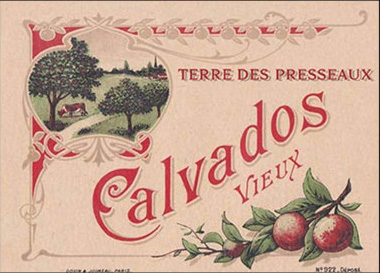
The new Terre des Presseaux orchard
« Each apple is a flower that once knew love » (Félix Leclerc). This land "Terre des Presseaux" has always been a famous vintage. In 1977, a fourth generation, the Dubourg family, took up the orchard fallen into disuse. The old decaying trees were pulled out and 31 carefully selected varieties were introduced, including local ones like Gros Bois de Bayeux and Cartigny. 10 000 half standard and 2000 tall standard apple trees were planted on 40 hectares. The apple trees have been optimally distributed in the fields and protected from the wind with hedges. They are spaced out to get the maximum sunlight. "Space lost for better quality". The orchard is organic and pollination provided by the bees.
In 1992, La Ferme Manoir du Pavillon was leased to Ghislaine Dubourg who undertook major restoration on its agricultural parts. From then on it was named "La Ferme Manoir du Pavillon Terre des Presseaux". In August 1989, Grégory Dubourg, 10 years old, named Patrick Tabarly's boat "L'Esprit de Liberté" with cider instead of champagne! Patrick Tabarly was to win the Whitbread Round the World Sailing Cup the same year. More than a thousand guests discovered and enjoyed the first "Manoir du Pavillon" cider vintage.
The Calvados Terre des Presseaux blossoming
The Terre des Presseaux harvest
It is done from October to December. Apples are exclusively handpicked on the estate, then placed on wooden ''palox" (store room for fruits) to mature. They are to be controlled in order to ground them at their best aromatic stage.
The Terre des Presseaux brewing
After having been carefully ground, the Calvados flavours come from the peel; the pulp is collected and clamped into hessian bags, stocked on trays one over the other and put into the press. Traditional methods are used throughout the whole process. The apple juice obtained from the press is stored for over a year.
The Terre des Presseaux fermentation
The clarification is fully natural and free of any chemicals. Fermentation solely depends on the sugar "opening out". It will last from 1 to 2 years slowly turning sugar into alcohol.
The Terre des Presseaux distillation
Alcohol comes from the sugar’s fermentation that is under the form of glucose contained in the fruit. It brings along many other components that have to be isolated during the distillation process. This distillation process brings the cider brandy up to 70°. At this point, the spirit colourless until it matures.
The Terre des Presseaux cooperage
Essentially 220 to 420 litre oak tree barrels are used. The oak trees are from French forests in the Troncais and Limousin regions. Oak trees from Le Tronçais (Normandy) present a fine and tender grained wood. It is porous to raw spirit and gives Calvados its soft tannin. The ones from Limousin have a medium grain are harder and more nervous. However, they are more porous. This gives the Calvados’ strength. The wine cellar also has a few casks made out of white American oak that brings extremely low tannin rates and numerous, rich aromatic essences. 6 "bussards" having formerly stored rhum, whiskey, port, cognac, armagnac and vodka are kept for rare vintages. Centenarian "tierçons" from the Limousin are reserved for storing the exceptionally rare Calvados. process. This distillation process brings the cider brandy up to 70°. At this point, the spirit colourless until it matures.
The Terre des Presseaux ageing
The crucial point is the cellar master know-how. Thanks to its proximity to the sea, the ageing process takes place in humid cellars providing flexibility and an exceptional softness to the Calvados Terre des Presseaux. Maturation takes a long time and is achieved through the wood porosity by a mysterious exchange between the spirit and the surrounding air. The oak wood enhances the aroma of the apple with a subtle bouquet and most exquisite flavours. The important stock of old Calvados Terre des Presseaux can ensure a high standard quality. Moreover, Calvados Terre des Presseaux is only sold after 12 years of maturity in the oak casks. The Calvados will have progressively lost its "fire" and the tannins will have been transformed into the different aromas. According to the number of years, Calvados Terre des Presseaux will develop miscellaneous flavours like vanilla, coffee, coconut, caramel, apricot or dried fruits.
The Terre des Presseaux cellar master
Blending is an art, more, a sublimation. It is not a mix of different Calvados. Through the wood, the Calvados will breath. The cellar master is a conductor who controls time and blending. He is both an artisan and an artist.
The Terre des Presseaux angels share
Calvados needs to breathe through the wood. It creates 'the angels share', this part of the brandy that vanishes by evaporation. The barrels are half filled in order to create a maximum of evaporation enabling its intensification, complexity and concentration of aromas for an exceptional quality.
The Terre des Presseaux bottling
Bottling is done manually on the estate after a cold filtration process. It ensures the Calvados’ high standard. 3000 bottles are produced each year.
The purity of lines
Ligne Prestige Terre des Presseaux
« Nature, which puts on the invisible the mask of the visible, is an appearance corrected by a transparency » (Victor Hugo) Ghislaine Dubourg drew her inspiration from XVIIIth century bottles to create her 3 size bottles (35CL, 70CL and 150CL) for the Luxury Ligne Prestige. As of 1990, she chose transparency, referring to Armagnac bottle, refusing the opacity of other brandy bottles. Thus, customers can enjoy the magnificent colours of the Calvados "Terre des Presseaux".
Ligne Cristal Terre des Presseaux
« Style is like crystal, its purity gives its brilliance » (Victor Hugo). The Ligne Cristal was conceived and carried out by the crystal manufacturer "Les Cristalleries de Bohême".
Cave Cristal Terre des Presseaux
At the end of the XVIIIth century, the first crystal drink cabinets were used to help to pass the time pleasantly on long journeys. Around 1850, the growing bourgeoisie discovered the charms of luxury and design. It encouraged the use of refined objects such as tea boxes as well as cigar and liquor cabinets. George Sand is said to have started this trend. Drink cabinets expanded under the Second Empire and could be found in the shops of the Palais Royal. Some artisan manufacturers such as Cristal du Creusot, St Louis, Sèvres, Baccarat reached an extreme refinement : moulding, carving, acid cutting or diamond shaping, as well as finished with fine gold. There was no limit to inventiveness. By 1840, new decanters, all made in Bohemia came along to enrich the existing offer. Manufactured there, “La Cave de Cristal” Terre des Presseaux revives the old tradition. Exceptional carafes for exceptional Calvados.
Ligne Diamant Terre des Presseaux
« Light is the soul of diamond » (Joseph Joubert). Exceptional carafes for exceptional Calvados. Once again Ghislaine Dubourg ambitioned to enhance the outstanding values of Calvados Terre des Presseaux and its wonderful gleams by designing a liquor decanter in the most appropriate shape. She chose the diamond shape. Nothing but this shape could bring light and reflection to the Calvados “Terre des Presseaux”. Our exceptional products Ligne Diamant and Cave Cristal are not qualified as vintage. It is an association of our best cuvées, whose the youngest is 20 years old. We are not allowed to reveal the age of other cuvées, all older.
Apple Spirit
Myths in bottles Produced from the same terroir and raised with the same rigor as the Calvados Terre des Presseaux, vodkas from the Apple Spirit line are made from 100% organic apples, 100% pure. From apple to bottle, purity and transparency are de rigueur. But we keep a part of mystery notably on the distribution, the dosage and the varieties of apples that compose our line Apple Spirit. A part of mystery and myth for magic to work. -Pure The best apples grow at the Garden of Eden ... but the purest are picked up by hand on the land called "Terre des Presseaux". The idea came from one of the best bartender in the world who asked us to develop a pure, fruity Vodka, with divine apple flavors, noble in spirit but young and fresh to taste and eat consumed or for The development of its cocktails. -Paris The Garden of the Hesperides is full of golden apples ... one of which was sent to three Greek goddesses. The gods charged a shepherd named Paris to designate the most beautiful of the three. Suspended to her judgment, Aphrodite (goddess of love) was the happy chosen. That's why today we find golden apple barks suspended in Apple Brandy Pâris Vodka.

